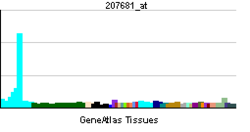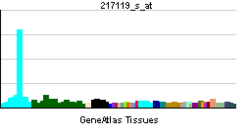- CXCR3
-
Chemokine (C-X-C motif) receptor 3 Identifiers Symbols CXCR3; CD182; CD183; CKR-L2; CMKAR3; GPR9; IP10-R; Mig-R; MigR External IDs OMIM: 300574 MGI: 1277207 HomoloGene: 1153 IUPHAR: CXCR3 GeneCards: CXCR3 Gene Gene Ontology Molecular function • receptor activity
• G-protein coupled receptor activity
• chemokine receptor activity
• C-X-C chemokine receptor activity
• chemokine bindingCellular component • cytoplasm
• plasma membrane
• plasma membrane
• integral to plasma membraneBiological process • cellular component movement
• chemotaxis
• cell adhesion
• elevation of cytosolic calcium ion concentrationSources: Amigo / QuickGO RNA expression pattern 

More reference expression data Orthologs Species Human Mouse Entrez 2833 12766 Ensembl ENSG00000186810 ENSMUSG00000050232 UniProt P49682 O88410 RefSeq (mRNA) NM_001142797.1 NM_009910.2 RefSeq (protein) NP_001136269.1 NP_034040.1 Location (UCSC) Chr X:
70.84 – 70.84 MbChr X:
98.93 – 98.93 MbPubMed search [1] [2] Chemokine receptor CXCR3 is a Gαi protein-coupled receptor in the CXC chemokine receptor family. Other names for CXCR3 are G protein-coupled receptor 9 (GPR9) and CD183. There are two variants of CXCR3: CXCR3-A binds to the CXC chemokines CXCL9 (MIG), CXCL10 (IP-10), and CXCL11 (I-TAC)[1] whereas CXCR3-B can also bind to CXCL4 in addition to CXCL9, CXCL10, and CXCL11.[2]
Contents
Expression
CXCR3 is expressed primarily on activated T lymphocytes and NK cells,[3] and some epithelial cells and some endothelial cells. CXCR3 and CCR5 are preferentially expressed on Th1 cells, whereas Th2 cells favor the expression of CCR3 and CCR4. CXCR3 ligands that attract Th1 cells can concomitantly block the migration of Th2 cells in response to CCR3 ligands, thus enhancing the polarization of effector T cell recruitment.
Signal transduction
Binding of CXCL9, CXCL10, and CXCL11 to CXCR3 is able to elicit increases in intracellular Ca2++ levels and activate phosphoinositide 3-kinase and mitogen-activated protein kinase (MAPK).[4] Detailed signaling pathway has not yet been established, but may include the same enzymes that were identified in the signaling cascade induced by other chemokine receptors.
Function
CXCR3 is able to regulate leukocyte trafficking. Binding of chemokines to CXCR3 induces various cellular responses, most notably integrin activation, cytoskeletal changes and chemotactic migration. CXCR3-ligand interaction attracts Th1 cells and promotes Th1 cell maturation.
As a consequence of chemokine-induced cellular desensitization (phosphorylation-dependent receptor internalization), cellular responses are typically rapid and short in duration. Cellular responsiveness is restored after dephosphorylation of intracellular receptors and subsequent recycling to the cell surface. A hallmark of CXCR3 is its prominent expression in in vitro cultured effector/memory T cells, and in T cells present in many types of inflamed tissues. In addition, CXCL9, CXCL10 and CXCL11 are commonly produced by local cells in inflammatory lesion, suggesting that CXCR3 and its chemokines participate in the recruitment of inflammatory cells.[5] Additionally, CXCR3 has been implicated in wound healing.[6]
Disease
CXCR3 has been implicated in the following diseases, atherosclerosis,[7] multiple sclerosis,[8] pulmonary fibrosis,[9] type 1 diabetes,[10] autoimmune myasthenia gravis, nephrotoxic nephritis[11], acute cardiac allograft rejection[12] and possibly Celiac Disease[13]. Development of agents to block CXCR3-ligand interactions may provide new ways to treat these diseases.
Pharmacology
Recent reports indicate that there is a significant interest for the identification of small-molecule antagonists of CXCR3 [14]. Several small molecules [15] were found to constitute a promising series of functional antagonists of CXCR3 that could be developed into new therapeutic agents for the treatment of inflammatory disorders such as rheumatoid arthritis, inflammatory bowel disease,multiple sclerosis and diabetes. More recently the first QSAR study concerning antagonists of CXCR3 has been published in the literature. The in silico model provides a time- and cost-effective tool for the screening of existing and virtual libraries of small molecules as well as for designing of novel molecules of desired activity [16].
Interactions
CXCR3 has been shown to interact with CXCL9.[2][17]
See also
- Chemokine receptors
- Chemokine
- Cluster of differentiation
References
- ^ Clark-Lewis I, Mattioli I, Gong JH, Loetscher P (2003). "Structure-function relationship between the human chemokine receptor CXCR3 and its ligands". J. Biol. Chem. 278 (1): 289–95. doi:10.1074/jbc.M209470200. PMID 12417585.
- ^ a b Lasagni L, Francalanci M, Annunziato F, Lazzeri E, Giannini S, Cosmi L, Sagrinati C, Mazzinghi B, Orlando C, Maggi E, Marra F, Romagnani S, Serio M, Romagnani P (2003). "An Alternatively Spliced Variant of CXCR3 Mediates the Inhibition of Endothelial Cell Growth Induced by IP-10, Mig, and I-TAC, and Acts as Functional Receptor for Platelet Factor 4". J. Exp. Med. 197 (11): 1537–49. doi:10.1084/jem.20021897. PMC 2193908. PMID 12782716. http://www.pubmedcentral.nih.gov/articlerender.fcgi?tool=pmcentrez&artid=2193908.
- ^ Qin S, Rottman JB, Myers P, Kassam N, Weinblatt M, Loetscher M, Koch AE, Moser B, Mackay CR (1998). "The chemokine receptors CXCR3 and CCR5 mark subsets of T cells associated with certain inflammatory reactions". J. Clin. Invest. 101 (4): 746–54. doi:10.1172/JCI1422. PMC 508621. PMID 9466968. http://www.pubmedcentral.nih.gov/articlerender.fcgi?tool=pmcentrez&artid=508621.
- ^ Smit MJ, Verdijk P, van der Raaij-Helmer EM, Navis M, Hensbergen PJ, Leurs R, Tensen CP (2003). "CXCR3-mediated chemotaxis of human T cells is regulated by a Gi- and phospholipase C-dependent pathway and not via activation of MEK/p44/p42 MAPK nor Akt/PI-3 kinase". Blood 102 (6): 1959–65. doi:10.1182/blood-2002-12-3945. PMID 12750173.
- ^ "Entrez Gene: CXCR3 chemokine (C-X-C motif) receptor 3". http://www.ncbi.nlm.nih.gov/sites/entrez?Db=gene&Cmd=ShowDetailView&TermToSearch=2833.
- ^ Yates CC, Whaley D, Kulasekeran P, Hancock WW, Lu B, Bodnar R, Newsome J, Hebda PA, Wells A (2007). "Delayed and Deficient Dermal Maturation in Mice Lacking the CXCR3 ELR-Negative CXC Chemokine Receptor". Am. J. Pathol. 171 (2): 484–95. doi:10.2353/ajpath.2007.061092. PMC 1934531. PMID 17600132. http://www.pubmedcentral.nih.gov/articlerender.fcgi?tool=pmcentrez&artid=1934531.
- ^ Mach F, Sauty A, Iarossi AS, Sukhova GK, Neote K, Libby P, Luster AD (1999). "Differential expression of three T lymphocyte-activating CXC chemokines by human atheroma-associated cells". J. Clin. Invest. 104 (8): 1041–50. doi:10.1172/JCI6993. PMC 408576. PMID 10525042. http://www.pubmedcentral.nih.gov/articlerender.fcgi?tool=pmcentrez&artid=408576.
- ^ Sørensen TL, Tani M, Jensen J, Pierce V, Lucchinetti C, Folcik VA, Qin S, Rottman J, Sellebjerg F, Strieter RM, Frederiksen JL, Ransohoff RM (1999). "Expression of specific chemokines and chemokine receptors in the central nervous system of multiple sclerosis patients". J. Clin. Invest. 103 (6): 807–15. doi:10.1172/JCI5150. PMC 408141. PMID 10079101. http://www.pubmedcentral.nih.gov/articlerender.fcgi?tool=pmcentrez&artid=408141.
- ^ Jiang D, Liang J, Hodge J, Lu B, Zhu Z, Yu S, Fan J, Gao Y, Yin Z, Homer R, Gerard C, Noble PW (2004). "Regulation of pulmonary fibrosis by chemokine receptor CXCR3". J. Clin. Invest. 114 (2): 291–9. doi:10.1172/JCI200416861. PMC 449741. PMID 15254596. http://www.pubmedcentral.nih.gov/articlerender.fcgi?tool=pmcentrez&artid=449741.
- ^ Frigerio S, Junt T, Lu B, Gerard C, Zumsteg U, Holländer GA, Piali L (2002). "Beta cells are responsible for CXCR3-mediated T-cell infiltration in insulitis". Nat. Med. 8 (12): 1414–20. doi:10.1038/nm792. PMID 12415259.
- ^ Panzer U, Steinmetz OM, Paust HJ, Meyer-Schwesinger C, Peters A, Turner JE, Zahner G, Heymann F, Kurts C, Hopfer H, Helmchen U, Haag F, Schneider A, Stahl RA (2007). "Chemokine receptor CXCR3 mediates T cell recruitment and tissue injury in nephrotoxic nephritis in mice". J. Am. Soc. Nephrol. 18 (7): 2071–84. doi:10.1681/ASN.2006111237. PMID 17538187.
- ^ Hancock WW, Lu B, Gao W, Csizmadia V, Faia K, King JA, Smiley ST, Ling M, Gerard NP, Gerard C (2000). "Requirement of the Chemokine Receptor CXCR3 for Acute Allograft Rejection". J. Exp. Med. 192 (10): 1515–20. doi:10.1084/jem.192.10.1515. PMC 2193193. PMID 11085753. http://www.pubmedcentral.nih.gov/articlerender.fcgi?tool=pmcentrez&artid=2193193.
- ^ Lammers KM, Lu R, Brownley J, Lu B, Gerard C, Thomas K, Rallabhandi P, Shea-Donohue T, Tamiz A, Alkan S, Netzel-Arnett S, Antalis T, Vogel SN, Fasano A. (2008). "Gliadin Induces an Increase in Intestinal Permeability and Zonulin Release by Binding to the Chemokine Receptor CXCR3". Gastroenterology 135 (1): 194–204.e3. doi:10.1053/j.gastro.2008.03.023. PMC 2653457. PMID 18485912. http://www.pubmedcentral.nih.gov/articlerender.fcgi?tool=pmcentrez&artid=2653457.
- ^ Watson RJ, Allen DR, Birch HL, et al. (January 2008). "Development of CXCR3 antagonists. Part 3: Tropenyl and homotropenyl-piperidine urea derivatives". Bioorg. Med. Chem. Lett. 18 (1): 147–51. doi:10.1016/j.bmcl.2007.10.109. PMID 18032038.
- ^ Watson RJ, Allen DR, Birch HL, et al. (December 2007). "Development of CXCR3 antagonists. Part 2: Identification of 2-amino(4-piperidinyl)azoles as potent CXCR3 antagonists". Bioorg. Med. Chem. Lett. 17 (24): 6806–10. doi:10.1016/j.bmcl.2007.10.029. PMID 17964154.
- ^ Afantitis A, Melagraki G, Sarimveis H, Igglessi-Markopoulou O, Kollias G (July 2008). "A novel QSAR model for predicting the inhibition of CXCR3 receptor by 4-N-aryl-[1,4] diazepane ureas". Eur J Med Chem 44 (2): 877–84. doi:10.1016/j.ejmech.2008.05.028. PMID 18619714.
- ^ Weng, Y; Siciliano S J, Waldburger K E, Sirotina-Meisher A, Staruch M J, Daugherty B L, Gould S L, Springer M S, DeMartino J A (Jul. 1998). "Binding and functional properties of recombinant and endogenous CXCR3 chemokine receptors". J. Biol. Chem. (UNITED STATES) 273 (29): 18288–91. doi:10.1074/jbc.273.29.18288. ISSN 0021-9258. PMID 9660793.
External links
- "Chemokine Receptors: CXCR3". IUPHAR Database of Receptors and Ion Channels. International Union of Basic and Clinical Pharmacology. http://www.iuphar-db.org/GPCR/ReceptorDisplayForward?receptorID=2214.
- MeSH CD183+Antigen
Cytokine receptors Chemokine receptor
(GPCRs)OtherTNF receptor 1-1011-2021-25JAK-STAT OtherIg superfamily IL-17 family S/T Categories:- Human proteins
- Clusters of differentiation
Wikimedia Foundation. 2010.
